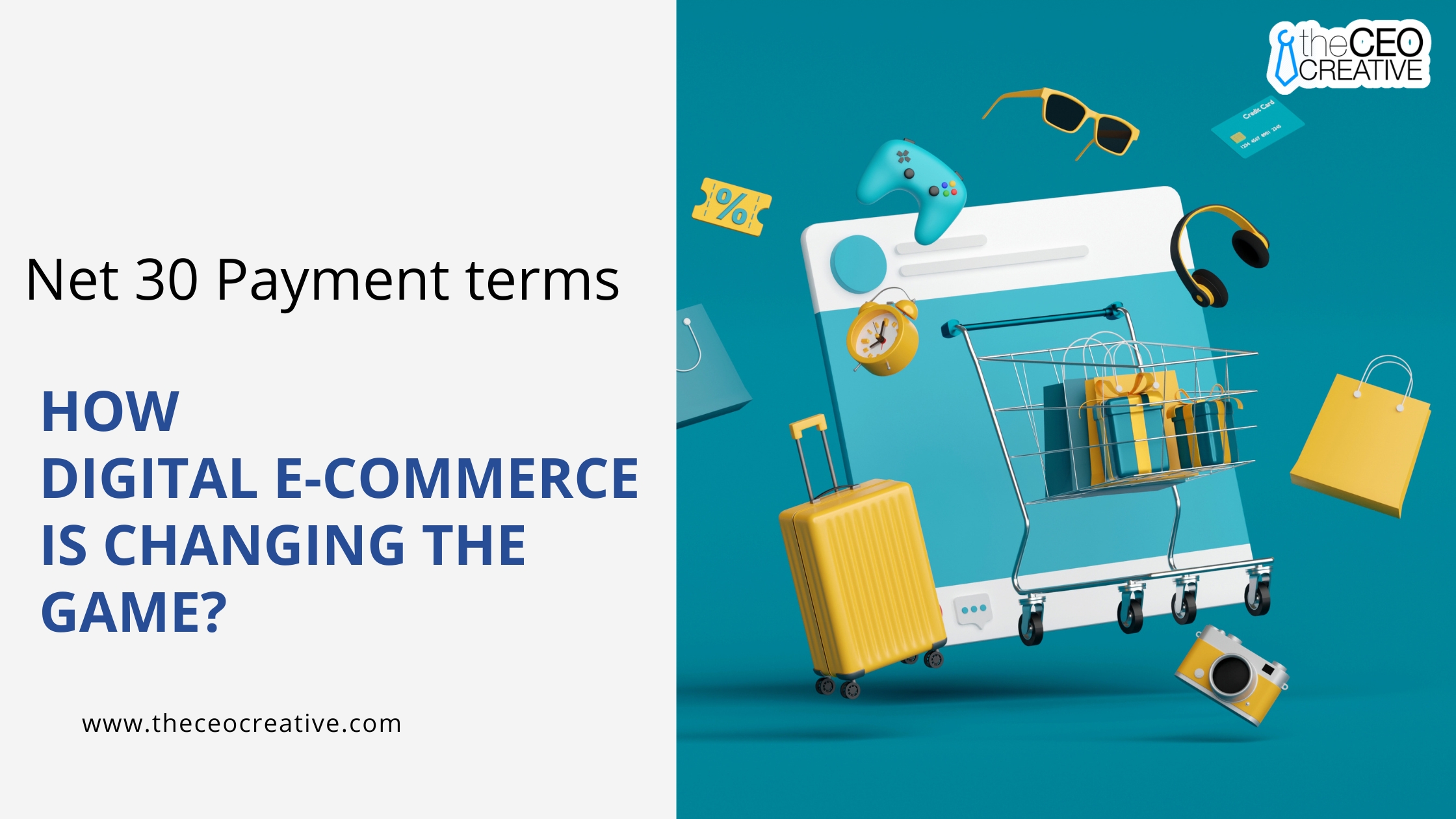In today’s fast-paced world of digital commerce, traditional business practices like Net 30 payment terms are being reshaped under the influence of digital e-commerce.
Net 30, allowing buyers to pay for goods or services within 30 days, has been a bedrock of B2B transactions for decades. Yet, the rise of online business demands a rethinking of this practice, urging businesses to adapt their payment strategies to the ever-changing digital landscape.
Digital e-commerce is not only speeding up the pace of transactions but also expanding the scope, offering new opportunities for businesses and entrepreneurs.
Understanding Net 30’s nuances and its evolving role in the digital age is crucial for success in modern commerce. In this blog, we’ll explore how digital e-commerce is transforming Net 30 payment terms, ensuring businesses stay ahead by leveraging digital payments and embracing the dynamic world of online transactions.
What is Net 30?
Definition and Historical Context
Net 30 is a term steeped in tradition, widely used in the world of business transactions. At its core, it represents an agreement between a buyer and a seller where the buyer is allowed to pay for goods or services within 30 days of receiving an invoice. Picture it as a short-term credit line that offers buyers the wiggle room to use the goods or services and temporarily hold onto their cash.
Historically, Net 30 has been a trusted cornerstone in B2B (business-to-business) relationships. Back in the day, it was a lifeline for businesses allowing them to maintain smooth cash flow by buying on credit while simultaneously selling their own products or services.
This gently oiled the wheels of commerce, creating a win-win scenario: buyers had extra time to manage their funds, and sellers could count on a steady stream of loyal customers.
Importance in B2B Transactions
In the realm of B2B transactions, Net 30 is invaluable. It plays a crucial role in establishing trust and nurturing long-standing relationships between businesses.
By offering this period of leeway, sellers demonstrate faith in buyers, while buyers benefit from having time to organize their resources without immediately parting with cash. This mutual dependence is pivotal in making business operations run smoothly and efficiently, enhancing the likelihood of repeat collaborations.
Benefits of Net 30 in the Digital Age
While the digital world is all about speed and instant gratification, Net 30 continues to offer significant advantages, enhancing its charm in today’s e-commerce landscape.
For Buyers: Financial Flexibility
– Enhanced Cash Flow Management: In business, cash flow is like oxygen. Net 30 gives buyers breathing space, enabling them to manage cash flow efficiently. This extended period is particularly helpful when tackling unexpected expenses or investing in growth opportunities without immediate cash strain.
– Risk Mitigation and Assurance: The digital marketplace often involves buying intangible or remotely delivered goods. Net 30 allows buyers to inspect and ensure the purchased goods meet their expectations before committing to payment, significantly reducing the risk of disputes or dissatisfaction.
– Strategic Planning: There’s smart financial planning in delaying payments without incurring penalties. Buyers can optimize their financial strategies, redirect funds to investment opportunities, and take advantage of any early payment discounts that might come their way. For startups and small firms, this flexibility can be a game-changer.
For Sellers: Growth and Loyalty
– Stimulating Sales: In the cutthroat world of digital e-commerce, flexibility can make a big difference. Offering Net 30 terms can be enticing for potential customers, possibly leading to increased order sizes or attracting new clientele who may otherwise be hesitant to commit.
– Building Trust and Long-term Relationships: Extending Net 30 not only opens doors to new customers but also strengthens existing bonds. This offering is a testament to the seller’s trust in the buyer’s reliability, fostering loyalty and perhaps leading to glowing recommendations and repeat business.
– Simplified Accounting: Despite the availability of advanced digital tools, Net 30 remains wonderfully straightforward. With clearly defined terms and predictable cycles, it continues to simplify financial tracking within the tumultuous e-commerce environment.
Overall Advantages
The symbiotic nature of Net 30 is unmatched, offering a seamless bridge between the financial needs of buyers and the operational realities of sellers. In an era defined by rapid digital transformations, Net 30 emerges as a classic tool with a modern twist, capable of fostering relationships, managing cash flow, and driving growth.
Whether you are a buyer appreciating the breathing room or a seller welcoming more clients, Net 30 can still be the go-to option, even as digital e-commerce opens doors to alternative payment methods.
As both sides navigate the digital transformation, understanding and leveraging the strategic advantages of Net 30 can prove pivotal in securing a competitive edge and evolving with the changing digital tides.
Navigating the Challenges of Net 30
While Net 30 undoubtedly provides numerous benefits, applying it in the fast-paced world of e-commerce comes with its own set of challenges. Let’s delve into these hurdles to better understand what businesses face today.
Cash Flow Constraints for Sellers
Offering Net 30 terms can initially sound appealing for increasing customer acquisition, but it may create a significant strain on the seller’s cash flow.
The practice of allowing buyers a 30-day payment window can lead to a temporary shortfall in working capital. This gap can impact a seller’s ability to manage day-to-day operations, invest in growth, or respond rapidly to financial emergencies.
For instance, consider a scenario where large orders are placed and fulfilled simultaneously. The seller must cover production and shipping costs upfront, while waiting for the payment delay to lift. This waiting period can be daunting, especially if the cash reserves are limited or if the market conditions suddenly change.
Risk of Late Payments and Defaults
Punctual cash flow is the lifeline of any business. Unfortunately, with Net 30 terms, the risk of late payments or defaults is ever-present. In the digital marketplace, where transactions are often faceless and geographically dispersed, sellers might find it challenging to assess a buyer’s financial standing accurately. This challenge is further compounded by the potential for buyers to delay payments intentionally or, in worst-case scenarios, not pay at all.
Late payments can disrupt a company’s financial health, setting off a chain reaction of delayed obligations to other vendors or stakeholders. Defaults, on the other hand, might incur losses so severe that they impact overall business viability. Therefore, sellers need robust credit checks and risk management strategies to mitigate these risks.
Administrative and Global Considerations
While digital tools have streamlined many processes, managing Net 30 terms still requires considerable administrative effort. This can include sending invoices, processing payments, handling reminders, and following up on overdue accounts. Each step involves time and resources that could otherwise be channeled into core business activities.
On a global scale, as e-commerce erases geographical boundaries, sellers find themselves dealing with international customers. This expansion introduces complexities such as different payment systems, currency conversion rates, and potential delays in cross-border transactions. These factors make it imperative for businesses to handle administrative tasks meticulously to ensure seamless financial operations.
E-commerce: The Catalyst for Change

E-commerce has been a tremendous force in reshaping traditional business practices, and Net 30 terms are no exception. Let’s explore how e-commerce acts as a catalyst for evolving these payment terms.
Speed and Scale: Need for Agility
The digital marketplace operates at breakneck speed. Transactions are swift, and the sheer volume of sales can be overwhelming. In this fast-paced environment, the agility in managing payments is paramount.
While Net 30 still provides buyers with some breathing room, sellers need efficient cash flow management systems to keep the business nimble and responsive to changes.
The ability to process large volumes of transactions quickly and smoothly can set a business apart from the competition. Therefore, adopting measures to manage the risks associated with prolonged payment terms is vital.
Global Marketplace Challenges
E-commerce opens doors to customers worldwide, allowing a local business to transform into an international player overnight. While this global reach presents immense growth opportunities, it also increases competition.
Offering Net 30 terms can be a strategic move to win customer loyalty across the globe. However, doing so requires understanding and adapting to various cultural and economic nuances of different markets.
By integrating a global perspective, businesses offering Net 30 terms can better compete by providing the flexible payment schedules that varied customer bases might prefer or expect.
Rise of Alternative Payment Solutions
The digital revolution has introduced a range of alternative payment methods that contest the long-established Net 30 model. Options such as digital wallets, Buy Now Pay Later (BNPL) services, and cryptocurrencies offer buyers more flexibility and convenience.
To stay competitive, sellers must be open to embracing these emerging payment trends. By providing a diversified array of payment options, businesses can cater to the evolving preferences of today’s digital-savvy consumers. A dynamic offering might involve combining Net 30 terms for particular clients with more immediate or alternative payment solutions for others.
In conclusion, while the traditional Net 30 terms face a few hurdles in the digital economy, e-commerce provides a platform to innovate and adapt. Sellers can leverage technology, new payment solutions, and global insights to refine their approaches sustainably, ensuring they thrive in the ever-evolving digital age. By navigating the challenges and embracing the changes, businesses can continue to benefit from the financial strategy that Net 30 offers.
The Future of Net 30 in Digital E-commerce
As e-commerce continues to redefine how business is conducted on a global scale, Net 30 payment terms are not left untouched by this wave of digital transformation.
To understand the future of Net 30 in the digital e-commerce realm, it’s essential to examine the adaptations that will keep this traditional payment method relevant in an increasingly digital world.
Customization and Flexibility
In the future, businesses are likely to move toward customizing payment terms to better accommodate their clients’ needs. This means that payment structures could become more tailored, taking into account a customer’s creditworthiness, purchasing history, and overall relationship with the seller. This personalized approach could enhance customer satisfaction while optimizing risk management for sellers.
Integration with Emerging Technologies
The integration of cutting-edge technologies such as blockchain and smart contracts could revolutionize how Net 30 transactions are managed. These technologies offer the potential for increased transparency and security, allowing both buyers and sellers to reduce the risk of fraudulent activities. By automating processes, the likelihood of human error decreases, making transactions smoother and more reliable.
Competition with Alternative Payment Solutions
With the rise of alternative payment options like digital wallets and Buy Now Pay Later (BNPL) services, the traditional Net 30 model faces competitive pressure.
To stay relevant, businesses using Net 30 terms will need to innovate and adapt, perhaps by combining their offerings with alternative payment solutions. This hybrid approach could attract a broader audience who seek both trust in traditional terms and the convenience of modern payment methods.
Embracing Technology and Data
The future of Net 30 in digital e-commerce will be heavily influenced by how businesses harness technology and data. By utilizing advanced data analytics, companies can gain insights into customer behavior, allowing for more informed decisions about payment terms.
Moreover, technology will continue to play a crucial role in streamlining transactions, from automated invoicing to payment reminders, which not only ease the administrative burden but also help in maintaining a healthy cash flow.
In conclusion, while the digital age presents challenges to the traditional Net 30 payment terms, it also offers opportunities for evolution and growth. By being flexible, integrating new technologies, and using data-driven strategies, businesses can successfully adapt Net 30 to fit the fast-paced, ever-changing landscape of e-commerce. This adaptability ensures that Net 30 remains a formidable player in managing cash flow optimization and fostering customer loyalty in the digital era.
Conclusion
The digital age has unquestionably transformed how businesses approach Net 30 payment terms. While these terms continue to serve as a beneficial tool for managing cash flow and nurturing customer relationships, their application in the e-commerce landscape demands innovation and adaptability.
Businesses must harness technology to streamline processes, offer diverse payment options, and make data-driven decisions. It’s about balancing traditional values with modern solutions, ensuring that Net 30 remains a viable and strategic choice in a rapidly evolving marketplace.
By staying ahead of trends and embracing digital transformation, companies can thrive and secure their place in the bustling world of online commerce.






